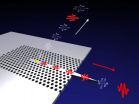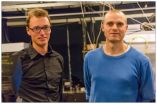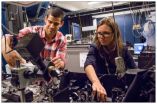(Press-News.org) Electronic circuits are based on electrons, but one of the most promising technologies for future quantum circuits are photonic circuits, i.e. circuits based on light (photons) instead of electrons. First, it is necessary to be able to create a stream of single photons and control their direction. Researchers around the world have made all sorts of attempts to achieve this control, but now scientists at the Niels Bohr Institute have succeeded in creating a steady stream of photons emitted one at a time and in a particular direction. The breakthrough has been published in the scientific journal Physical Review Letters.
Photons and electrons behave very differently at the quantum level. A quantum is the smallest unit in the atomic world and photons are the basic units of light and electrons of electrical current. Electrons are so-called fermions and can easily flow individually, while photons are bosons that prefer to clump together. But because information for quantum communication based on photonics lies in the individual photon, it is necessary to be able to send them one at a time.
"So you need to emit the photons from a fermionic system and we do this by creating an extremely strong interaction between light and matter," explains Peter Lodahl, Professor and head of the research group Quantum Photonics at the Niels Bohr Institute at the University of Copenhagen.
Photon canon
The researchers have developed a kind of single-photon cannon integrated on an optical chip. The optical chip consists of an extremely small photonic crystal that is 10 microns wide (1 micron is a thousandth of a millimeter) and 160 nanometers thick (1 nanometer is a thousandth of micron.) Embedded in the centre of the chip is a light source, a so-called quantum dot.
"What we then do is shine laser light on the quantum dot, where there are atoms with electrons in orbit around the nucleus. The laser light excites the electrons, which then jump from one orbit to another and thereby emit one photon at a time. Normally, light is scattered in all directions, but we have designed the photonic chip so that all of the photons are sent through only one channel," explains Søren Stobbe, Associate Professor of the Quantum Photonic research group at the Niels Bohr Institute.
Peter Lodahl and Søren Stobbe explain that it not only works, but also that it is extremely effective. "We can control the photons and send them in the direction we want with a 98.4 percent success rate. This is ultimate control over the interaction between matter and light and has amazing potential. Such a single-photon cannon has long been sought after in the research field and opens up fascinating new opportunities for fundamental experiments and new technologies," they explain.
The two researchers are in the process of patenting several parts of their work, with a specific goal of developing a prototype high-efficiency single-photon source, which could be used for encryption or for calculations of complex quantum mechanical problems and in general, is an essential building block for future quantum technologies. It is expected that the future's quantum technology will lead to new ways to code unbreakable information and to carry out complex parallel calculations.
INFORMATION:
For more information contact:
Peter Lodahl, Professor and head of the Quantum Photonic research group at the Niels Bohr Institute at the University of Copenhagen. Tel: +45 2056-5303, lodahl@nbi.ku.dk
Søren Stobbe, Associate Professor in the Quantum Photonic research group at the Niels Bohr Institute at the University of Copenhagen. Tel: +45 6065-6769, stobbe@nbi.ku.dk
Breakthrough in light sources for new quantum technology
2014-08-29
ELSE PRESS RELEASES FROM THIS DATE:
Real tremors, or drug-seeking patient? New app can tell
2014-08-29
A 42-year-old investment banker arrives at the emergency department with complaints of nausea, vomiting, anxiety and tremor. He drinks alcohol every day—often at business lunches, and at home every evening. Worried about his health, he decided to quit drinking and had his last Scotch 24 hours before coming to emergency.
It's a common scenario in emergency rooms across Canada—a patient suddenly stops regular, excessive alcohol consumption and develops withdrawal.
Withdrawal is a potentially fatal condition that is easily treated with benzodiazepine drugs, a class of ...
Socioeconomic status and gender are associated with differences in cholesterol levels
2014-08-29
A long-term lifestyle study reports differences between the sexes when it comes to fat profiles associated with socioeconomic status. Research in the open access journal BMC Public Health breaks down factors associated with social class and finds surprising inequalities between men and women.
The researchers found that men in social classes (based on occupation) with manual jobs had lower cholesterol levels than their counterparts in non-manual social classes. In contrast, women's LDL-cholesterol levels were more closely tied to their educational level than men.
The ...
Some women still don't underststand 'overdiagnosis' risk in breast screening
2014-08-29
A third of women who are given information about the chance of 'overdiagnosis' through the NHS breast screening programme may not fully understand the risks involved, according to research published in the British Journal of Cancer (BJC), today (Friday).
In a survey of around 2,200 women, Cancer Research UK scientists at University College London (UCL) found that 64 per cent felt they fully understood the information given about overdiagnosis – the chance that screening will pick up cancers that would never have gone on to cause any harm – by the National breast screening ...
High dietary salt may worsen multiple sclerosis symptoms
2014-08-29
Previous research has indicated that salt may alter the autoimmune response, which is implicated in the development of multiple sclerosis (MS), but it is not clear if it has any direct effect on the course of the disease itself.
The researchers assessed the blood and urine samples of 70 people with the relapsing-remitting form of MS to check for levels of salt; a marker of inflammatory activity called creatinine; and vitamin D, low levels of which have been linked to the disease.
This group were asked to provide urine samples on three separate occasions over a period ...
Plain cigarette packs don't hurt small retailers or boost trade in illicit tobacco
2014-08-29
The findings suggest there is no evidence for these particular arguments against the policy, put forward by the tobacco industry, say the researchers.
Australia was the first country in the world to introduce standardised packaging for tobacco products in December 2012. New Zealand, Ireland, and the UK are currently considering similar legislation.
The researchers wanted to find out if the policy would deter people from buying their tobacco from small independent retailers, prompt a rise in the availability of cheap products sourced from Asia, and increase the use of ...
New model predicts patients with type 1 diabetes who will go on to develop major complications
2014-08-29
New research published in Diabetologia (the journal of the European Association for the Study of Diabetes) presents a new model for predicting which patients with type 1 diabetes will go on to develop major complications, through easily and routinely measured risk factors. The research is by Assistant Professor Sabita Soedamah-Muthu, Wageningen University, Netherlands, and colleagues.
To create the model, data were analysed from 1,973 participants with type 1 diabetes followed for seven years in the EURODIAB Prospective Complications Study, and strong prognostic factors ...
The Lancet: China-themed issue
2014-08-29
China's rapid emergence as a global power has coincided with a series of unprecedented challenges to Chinese people's health. The fifth China themed issue of The Lancet provides a picture of the complex health issues facing China, and looks at how better health outcomes for Chinese people can be achieved into the future.
In this issue, the journal highlights the dire consequences that urbanisation and increasing affluence are having on China's chronic disease burden. The journal also reports systematic and comprehensive assessments of China's health-care system and revamping ...
Study finds shortcomings in doctor-patient discussions about transplantation
2014-08-29
Highlights
When dialysis patients reported discussions about transplantation with clinicians, they had a nearly 3-fold increased likelihood of being listed for transplantation, but clinician-reported discussions did not increase a patient's likelihood of being listed.
In almost one-third of cases, clinicians reported that they had discussed transplantation with a particular dialysis patient, but the patient said that nobody had discussed it with them.
Washington, DC (August 28, 2014) — In a study of dialysis patients, those who reported that they had discussed ...
Complications of tube insertion in ears not worse for kids with cleft lip/palate
2014-08-28
Bottom Line: Children with cleft lip and/or palate (CLP) have no worse complications from ventilation tube (VT) insertion in their ears to treat otitis media with effusion (OME, a buildup of fluid in the ear) or acute otitis media (AOM, a common ear infection), two conditions which can result in hearing loss.
Author: Ian Smillie, M.R.C.S. Ed., of the Royal Hospital for Sick Children, Glasgow, Scotland, and colleagues.
Background: CLP is a common birth defect in children, occurring in 1 of 700 births. Optimizing hearing in children with CLP is important to avoid problems ...
Socially-assistive robots help kids with autism learn by providing personalized prompts
2014-08-28
LOS ANGELES - August 28, 2014: This week, a team of researchers from the USC Viterbi School of Engineering will share results from a pilot study on the effects of using humanoid robots to help children with autism practice imitation behavior in order to encourage their autonomy. Findings from the study, entitled "Graded Cueing Feedback in Robot-Mediated Imitation Practice for Children with Autism Spectrum Disorders," will be presented at the 23rd IEEE International Symposium on Robot and Human Interactive Communication (RO-MAN) conference in Edinburgh, Scotland, on Aug. ...




